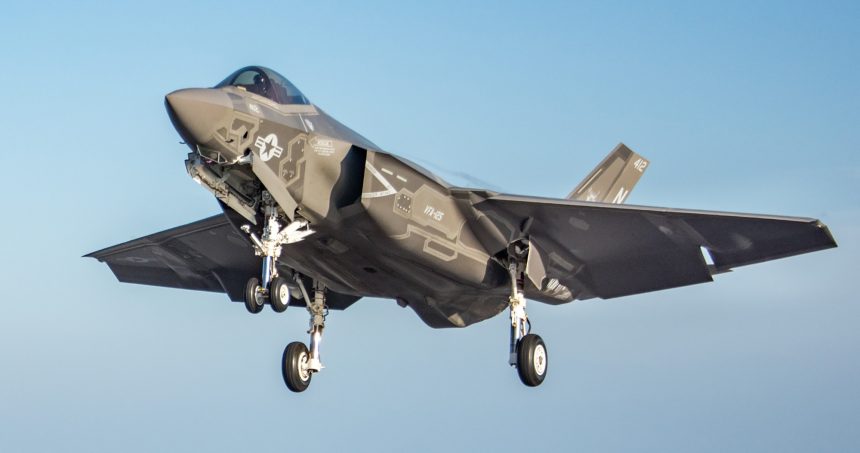A U.S. Navy F-35C with VFA-125 crashed at Naval Air Station Lemoore, California. The pilot ejected safely.
An F-35C Lightning II jet, attached to the “Rough Raiders” of VFA-125, from NAS Lemoore, California, crashed near the base at 18.30LT on Jul. 30, 2025.
The pilot ejected from the jet and is reported safe.
The U.S. Navy has now confirmed that an F-35C Lightning II with the “Rough Raiders” of Strike Fighter Squadron 125 (VFA-125) crashed earlier near Naval Air Station Lemoore in Central California. The pilot was able to successfully and safely eject prior to the crash, and was… pic.twitter.com/8gHPMXy66h
— OSINTdefender (@sentdefender) July 31, 2025
While the first reports circulated online said the 5th generation aircraft carried out an emergency landing and was later engulfed in flames, the base just published the following message on their social media channels, just confirming the incident and the status of the pilot:
“NAS Lemoore can confirm an aviation incident on the Operations side of the installation. At 1830, an F-35C attached to the VFA-125 Rough Raiders went down not far from NAS Lemoore. We can confirm the pilot successfully ejected and is safe. There are no additional affected personnel.”
F-35C crash in Fresno County – the latest on @KSEE24 at 11:00 pic.twitter.com/2Qs25M9eHv
— Eric Rucker (@EricRuckerNews) July 31, 2025
The VFA-125 is the west coast F-35C FRS (Fleet Replacement Squadron), responsible for training on the type. Previously known as RAG (Readiness Air Group), the role of the the unit is to train pilots and aircrews after flight training and before joining the fleet. FRSs also train aviators transitioning from other aircraft and ground crew, including mechanics.
We reported about VFA-125 in December 2023, when the unit had drawn attention for operating an F-35C featuring a distinctive mirror-like coating, previously observed only on test aircraft assigned to VX-9.
That aircraft was spotted performing touch-and-go landings aboard the USS Abraham Lincoln (CVN 72) on Nov. 30, 2023, marking the first time such a reflective scheme had been documented in a carrier environment. Unlike earlier examples, the coating on the Rough Raiders’ jet was limited to the vertical tails and wing sections, leaving the rest of the airframe with the standard low-observable finish. The reflective treatment appeared in alternating dark and shiny bands, possibly related to counter-IRST (Infrared Search and Track) measures or other sensor-related testing.
While the exact purpose of the coating remains unknown, its use on an FRS aircraft aboard a carrier suggested a possible evaluation of its durability under operational maritime conditions, where RAM (Radar Absorbent Material) is known to degrade rapidly. The sighting hinted at broader experimentation aimed at addressing the long-term survivability of stealth coatings at sea, an area of growing relevance for the F-35C fleet.
Previous incidents
This marks the second F-35 crash in 2025. The first occurred on January 28, when a U.S. Air Force F-35A went down within the perimeter of Eielson Air Force Base in Alaska. The pilot ejected safely. The incident quickly went viral after a dramatic video, filmed from the ramp near a KC-135R Stratotanker, showed the F-35A crashing with its landing gear down as a parachute drifted nearby.
At the same time, this is also the second F-35C crash ever: on Jan. 24, 2022, a U.S. Navy F-35C belonging to the VFA-147 “Argonauts” was lost at sea following a ramp strike while attempting to land on the USS Carl Vinson in the South China Sea. The aircraft, tail number 169304, went overboard after impact.
When the mishap happened, the pilot was returning from a routine four-hour mission with the callsign JASON 406, accompanied by another F-35C acting as flight lead. While returning to the aircraft carrier, the pilot requested to perform the so-called “Shit Hot” break for the first time.
The pilot ejected and was safely recovered from the water, while seven sailors were injured in the incident. This incident was also caught on camera. A video of the crash was leaked online, along with a photo showing the aircraft floating near the carrier just moments after hitting the sea. The image quickly circulated on social media, becoming the subject of various memes and humorous posts.
On Mar. 2, 2022, the wreckage was retrieved from a depth of approximately 12,400 feet using a remotely operated vehicle and the deep-diving vessel DSCV Picasso.
The investigation determined that cause of the mishap was found to be pilot error:
“The mishap pilot (MP) attempted an expedited recovery breaking overhead the carrier, an approved and common maneuver, but the MP had never performed this maneuver before, and it reduced the amount of time to configure the aircraft and conduct landing checks,” the report said. “As a result of the compressed timeline and the MP’s lack of familiarity with the maneuver, the MP lost situational awareness and failed to complete his landing checklist. Specifically, the MP remained in manual mode when he should have been (and thought he was) in an automated command mode designed to reduce pilot workload during landings.”









